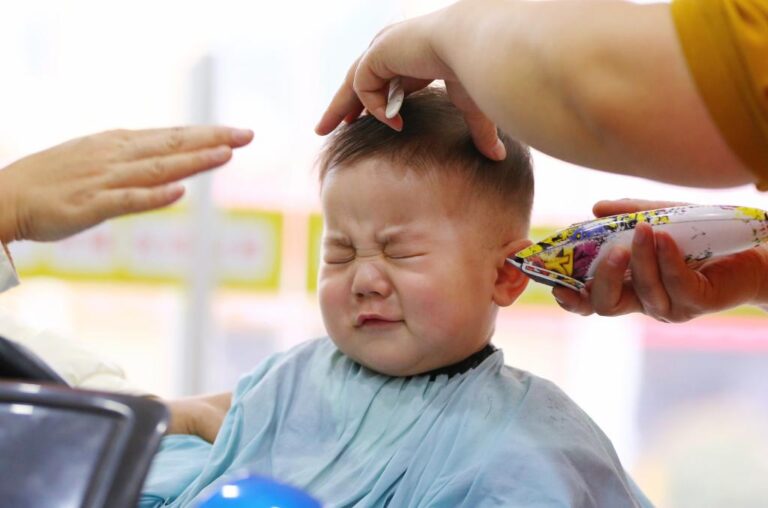(Photo by Li Zhijun/Xinhua)
BEIJING, March 21 (Xinhua) — Faced with the twin demographic challenges of a low fertility rate and a graying population, China is spearheading systemic policy innovations and people-oriented practices to bolster birth rates, boost consumption and drive sustainable socioeconomic growth in the coming decades and beyond.
This strategic emphasis on encouraging childbirth was underscored earlier this month during China’s national “two sessions,” where the term “provide childcare subsidies” was included for the first time in the annual government work report.
Additionally, a recently unveiled plan to increase consumption, proposes establishing a childcare subsidy system, expanding childbirth insurance coverage and enhancing pediatric services. These initiatives indicate that promoting childbirth has become a national strategic priority.
China’s total fertility rate has remained at around 1 for a few years, less than half of the required replacement level of 2.1. Meanwhile, the country’s degree of aging continues to increase. Data from the National Bureau of Statistics showed that those aged 65 years and above made up about 15.6 percent of the total population last year.
“Severe sub-replacement fertility will be China’s greatest economic and social challenge,” according to a recent article by veteran demographer James Liang, executive chair of China’s online travel service giant Trip.com Group.
Liang noted that only by prioritizing birth rate improvement, leveraging institutional strengths, and mobilizing social resources can the problem be effectively addressed.
In October 2024, a State Council directive outlined 13 targeted measures to enhance childbirth support services, expand child care systems, strengthen support in education, housing and employment, and foster a birth-friendly social atmosphere.
Earlier data from China’s national health authorities revealed that over 20 provincial-level regions had explored offering childcare subsidies at different levels, with more comprehensive versions being introduced recently.
The latest such measures were rolled out in north China’s Shanxi Province, where several counties introduced policies aimed at encouraging childbirth and alleviating family burdens by providing one-time childbirth subsidies, while partially covering hospitalization costs for childbirth.
For example, families in Xingxian County of the city of Lyuliang in Shanxi that give birth to their first, second or third child on or after Jan. 1, 2025, are eligible for one-time subsidies of 2,000 yuan (about 279 U.S. dollars), 5,000 yuan or 8,000 yuan, respectively.
Shenzhen in south China’s Guangdong Province, a city known for its economic vitality and inclusiveness and home to China’s largest migrant population, has also pledged to actively implement national initiatives by enhancing its childbirth support policy system and incentive mechanisms.
These developments follow Hohhot’s earlier announcement of a new childcare subsidy initiative, which attracted nationwide attention to this city, which is the capital of north China’s Inner Mongolia Autonomous Region, an area known for producing top quality milk, resulting in a boost for market confidence.
In Hohhot, couples having their first child will be offered a one-time payment of 10,000 yuan. For a second child, 50,000 yuan will be distributed in annual installments of 10,000 yuan. For all subsequent children, the same annual subsidy will be offered until the child turns 10, totaling 100,000 yuan, which is much higher than in other cities and amounts to roughly twice the annual income of local citizens.
These tangible subsidies are expected to drive consumption momentum in the maternal and infant product sector, according to Han Fei, vice president of Hohhot-based Yili Group, Asia’s largest dairy company. Han added that the city also plans to provide a daily cup of free milk for new mothers, which will accelerate the consumption of fresh milk in China’s dairy industry heartland.
Since 2013, China has implemented several rounds of progressive adjustments to adapt its population policies to evolving demographic and socioeconomic conditions. In 2021, it announced support for couples who wish to have a third child — and it is from that time onward that childbirth subsidies began to emerge.
Notably, the first city in China to offer such subsidies, Panzhihua in southwest China’s Sichuan Province, has witnessed positive growth in its permanent resident population for four consecutive years.
Meanwhile, Tianmen, a county-level city in central China’s Hubei Province, saw a year-on-year increase of 17 percent in its newborn population in 2024, significantly higher than the national average of 5.8 percent, and ending an eight-year decline. Among the 7,217 newborns in Tianmen, more than half were second or third children.
From baby bonuses and childcare subsidies to maternity leave allowances and home purchase incentives, total rewards for second and third children in Tianmen amount to 96,300 yuan and 165,100 yuan, respectively.
Tianmen’s tangible, holistic pro-birth policies also spurred a strong recovery in the real estate market of the city, where the average housing price is 5,000 yuan per square meter — attracting over 100 regions to conduct research and learn from its practices.
These cases show that financial incentives are probably the fastest way to boost fertility rates, and yet they are far from sufficient. Increased childcare services, extended maternity leave, and strengthened support in the fields of education, housing and employment, as well as a healthy marriage and childbirth culture, are also crucial in fostering a birth-friendly society. Encouragingly, various regions have already begun exploring such avenues.
Cash rewards ease financial burdens, but boosting birth rates requires tackling deeper issues like childcare challenges, work-life balance, and education costs, said Yue Ling, associate professor at the Beijing-based China University of Labor Relations.
Liang also highlighted the need for comprehensive measures including tax breaks, housing subsidies, increased childcare facilities, and promoting flexible work arrangements, to effectively boost willingness to have children.
Experts also emphasized the importance of coordinated consideration at both the national and local levels, to make support policies more reasonable, feasible and sustainable, as regional economic disparities can have an impact on the effectiveness of policies. ■

